



Acta Geodaetica et Cartographica Sinica ›› 2024, Vol. 53 ›› Issue (6): 1180-1194.doi: 10.11947/j.AGCS.2024.20230287
• Smart Surveying and Mapping • Previous Articles Next Articles
Xiaoqiang CHENG1,2( ), Na LIU1(
), Na LIU1( )
)
Received:2023-07-14
Published:2024-07-22
Contact:
Na LIU
E-mail:carto@hubu.edu.cn;2983046051@qq.com
About author:CHENG Xiaoqing (1985—), male, PhD, associate professor, majors in geographic information visualization. E-mail: carto@hubu.edu.cn
Supported by:CLC Number:
Xiaoqiang CHENG, Na LIU. Local clarity estimation and adaptive segmentation of line features based on positive and negative kernel density curves[J]. Acta Geodaetica et Cartographica Sinica, 2024, 53(6): 1180-1194.
Tab.1
Description of experimental data"
| 试验线要素 | 类别 | 经纬度范围 | 长度/m | 地区特征和数据特点 |
|---|---|---|---|---|
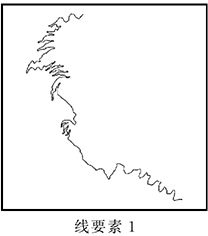 | 道路 | 28.08°N,103.57°E | 18 877.36 | 该地区山高坡陡,峡长谷深,地形地貌复杂;道路数据为盘山公路,局部蜿蜒曲折,局部平坦开阔,具备明显异质性 |
| — | ||||
| 28.03°N,103.63°E | ||||
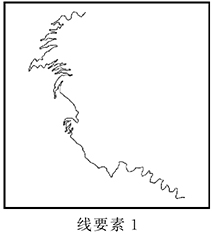 | 道路 | 27.73°N,103.88°E | 30 271.45 | |
| — | ||||
| 27.68°N,103.93°E | ||||
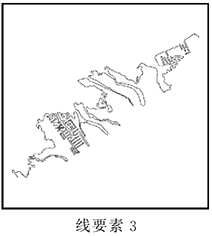 | 海岸线 | 29.22°N,95.00°W | 73 801.66 | 该地区海岸线受到人为活动影响,局部形态规则且密集,局部自然弯曲,具备显著异质性 |
| — | ||||
| 29.18°N,94.93°W | ||||
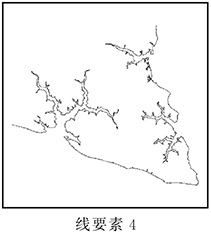 | 海岸线 | 35.47°N,76.69°W | 128 032.76 | 该沿海地区海岸线形态受人为影响较小,自然形成的局部细小分枝状弯曲和局部较大弯曲,数据具备明显异质性 |
| — | ||||
| 35.38°N,76.57°W | ||||
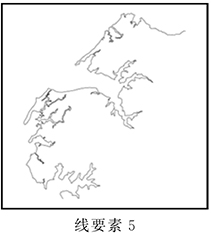 | 海岸线 | 37.66°N,75.89°W | 51 909.13 | 该沿海地区海岸线形态受人为影响较小,自然形成局部密集细小弯曲和局部较大弯曲,数据具备明显异质性 |
| — | ||||
| 37.63°N,75.85°W |
| [1] | 翟仁健, 武芳, 朱丽, 等. 曲线形态的结构化表达[J]. 测绘学报, 2009, 38(2):175-182. |
| ZHAI Renjian, WU Fang, ZHU Li, et al. Structured representation of curve shape[J]. Acta Geodaetica et Cartographica Sinica, 2009, 38(2):175-182. | |
| [2] | 朱鲲鹏, 武芳, 陈波, 等. 基于约束条件的线要素化简算法质量评估[J]. 测绘科学, 2007, 32(3):28-30, 192. |
| ZHU Kunpeng, WU Fang, CHEN Bo, et al. Quality assessment of linear features' simplification algorithms based on constraint conditions[J]. Science of Surveying and Mapping, 2007, 32(3):28-30, 192. | |
| [3] | 武芳, 巩现勇, 杜佳威. 地图制图综合回顾与前望[J]. 测绘学报, 2017, 46(10):1645-1664.DOI:10.11947/j.AGCS.2017.20170287. |
| WU Fang, GONG Xianyong, DU Jiawei. Overview of the research progress in automated map generalization[J]. Acta Geodaetica et Cartographica Sinica, 2017, 46(10):1645-1664.DOI:10.11947/j.AGCS.2017.20170287. | |
| [4] | SKOPELITI A, TSOULOS L. On the parametric description of the shape of the cartographic line[J]. Cartographica: the International Journal for Geographic Information and Geovisualization, 1999, 36(3):53-65. |
| [5] | STANĚK K, ŠILHÁK P, RYGLOVÁ A. A graphical generalization of localized morphological discontinuities on medium-scale state topographic maps[J]. Journal of Geovisualization and Spatial Analysis, 2022, 6(2):20. |
| [6] | 魏泓丞, 张立华, 唐露露, 等. 顾及局部差异的航海图线要素复杂度度量[J]. 测绘学报, 2022, 51(9):1959-1968.DOI:10.11947/j.AGCS.2022.20210129. |
| WEI Hongcheng, ZHANG Lihua, TANG Lulu, et al. Complexity measurement of line element on nautical chart considering local difference[J]. Acta Geodaetica et Cartographica Sinica, 2022, 51(9):1959-1968.DOI:10.11947/j.AGCS.2022.20210129. | |
| [7] | 杨敏, 陈果, 李连营, 等. 序列卷积神经网络支持下线状地图目标的分段方法[J]. 测绘学报, 2023, 52(1):108-116.DOI:10.11947/j.AGCS.2023.20210317. |
| YANG Min, CHEN Guo, LI Lianying, et al. Segmentation of linear map objects using sequential convolutional neural network[J]. Acta Geodaetica et Cartographica Sinica, 2023, 52(1):108-116.DOI:10.11947/j.AGCS.2023.20210317. | |
| [8] | 肖天元, 刘鹏程, 艾廷华, 等. 一种傅里叶信息度量的曲线分形描述与多尺度表达方法[J]. 武汉大学学报(信息科学版), 2020, 45(1):119-125. |
| XIAO Tianyuan, LIU Pengcheng, AI Tinghua, et al. A fractal description and multi-scale expression method of Fourier information metrics[J]. Geomatics and Information Science of Wuhan University, 2020, 45(1):119-125. | |
| [9] | 刘鹏程, 肖天元, 肖佳, 等. 曲线多尺度表达的Head-Tail信息量分割法[J]. 测绘学报, 2020, 49(7):921-933.DOI:10.11947/j.AGCS.2020.20200004. |
| LIU Pengcheng, XIAO Tianyuan, XIAO Jia, et al. A Head-Tail information break method oriented to multi-scale representation of polyline[J]. Acta Geodaetica et Cartographica Sinica, 2020, 49(7):921-933.DOI:10.11947/j.AGCS.2020.20200004. | |
| [10] | 刘慧敏, 樊子德, 邓敏, 等. 地图上等高线信息度量的层次方法研究[J]. 测绘学报, 2012, 41(5):777-783. |
| LIU Huimin, FAN Zide, DENG Min, et al. A hierarchical approach to measuring the information content of the contours in a map[J]. Acta Geodaetica et Cartographica Sinica, 2012, 41(5):777-783. | |
| [11] | 季宏超, 董箭, 李树军, 等. 顾及形态差异的TIN-DDM地形复杂度度量方法[J]. 测绘学报, 2023, 52(6):1010-1021.DOI:10.11947/j.AGCS.2023.20220074. |
| JI Hongchao, DONG Jian, LI Shujun, et al. TIN-DDM terrain complexity measurement method considering topographic forms differences[J]. Acta Geodaetica et Cartographica Sinica, 2023, 52(6):1010-1021.DOI:10.11947/j.AGCS.2023.20220074. | |
| [12] | 程绵绵, 孙群, 徐立, 等. 面轮廓线相似性和复杂性度量及在化简中的应用[J]. 测绘学报, 2019, 48(4):489-501.DOI:10.11947/j.AGCS.2019.20180124. |
| CHENG Mianmian, SUN Qun, XU Li, et al. Polygon contour similarity and complexity measurement and application in simplification[J]. Acta Geodaetica et Cartographica Sinica, 2019, 48(4):489-501.DOI:10.11947/j.AGCS.2019.20180124. | |
| [13] | LIU Minshi, HE Guifang, LONG Yi. A semantics-based trajectory segmentation simplification method[J]. Journal of Geovisualization and Spatial Analysis, 2021, 5(2):19. |
| [14] | BALBOA J L G, LÓPEZ F J A. Sinuosity pattern recognition of road features for segmentation purposes in cartographic generalization[J]. Pattern Recognition, 2009, 42(9):2150-2159. |
| [15] | 刘鹏程, 杨琴. 贝叶斯模型下面向地图表达的海岸线分段模型[J]. 计算机工程与应用, 2016, 52(22):174-179. |
| LIU Pengcheng, YANG Qin. Coastline segment model research for map generalization based on Bayesian method[J]. Computer Engineering and Applications, 2016, 52(22):174-179. | |
| [16] | DU Jiawei, WU Fang, XING Ruixing, et al. Segmentation and sampling method for complex polyline generalization based on a generative adversarial network[J]. Geocarto International, 2022, 37(14):4158-4180. |
| [17] | MITROPOULOS V, NAKOS B. A methodology on natural occurring lines segmentation and generalization[C]//Proceedings of the 14th ICA Workshop on Generalisation and Multiple Representation. Paris: ICA, 2011. |
| [18] | 陈军, 刘万增, 武昊, 等. 智能化测绘的基本问题与发展方向[J]. 测绘学报, 2021, 50(8):995-1005.DOI:10.11947/j.AGCS.2021.20210235. |
| CHEN Jun, LIU Wanzeng, WU Hao, et al. Smart surveying and mapping: fundamental issues and research agenda[J]. Acta Geodaetica et Cartographica Sinica, 2021, 50(8):995-1005.DOI:10.11947/j.AGCS.2021.20210235. | |
| [19] | 郝彤, 王晓峰, 冯甜甜, 等. 地球系统多尺度关键区域与关键过程的智能化测绘[J]. 测绘学报, 2021, 50(8):1084-1095.DOI:10.11947/j.AGCS.2021.20210109. |
| HAO Tong, WANG Xiaofeng, FENG Tiantian, et al. Intelligent and multi-scale surveying of key areas and processes of the Earth system[J]. Acta Geodaetica et Cartographica Sinica, 2021, 50(8):1084-1095.DOI:10.11947/j.AGCS.2021.20210109. | |
| [20] | 陈军, 艾廷华, 闫利, 等. 智能化测绘的混合计算范式与方法研究[J/OL]. 测绘学报: 1-19 [2024-05-25].http://kns.cnki.net/kcms/detail/11.2089.P.20240415.1049.002.html. |
| CHEN Jun, AI Tinghua, YAN Li, et al. Hybrid computational paradigm and methods for intelligentized surveying and mapping[J/OL]. Acta Geodaetica et Cartographica Sinica: 1-19 [2024-05-25]. http://kns.cnki.net/kcms/detail/11.2089.P.20240415.1049.002.html. | |
| [21] | 安晓亚, 成晓强. 矢量曲线的视觉清晰度及在网络地图综合中的应用[J]. 测绘学报, 2020, 49(2):245-255.DOI:10.11947/j.AGCS.2020.20190280. |
| AN Xiaoya, CHENG Xiaoqiang. Visual clarity of vector curve and its application in web map generalization[J]. Acta Geodaetica et Cartographica Sinica, 2020, 49(2):245-255. DOI:10.11947/j.AGCS.2020.20190280. | |
| [22] | SHEA K, MASTER R M. Cartographic generalization in a digital environment: when and how to generalize[C]//Proceedings of 1989 Auto-Carto 9. [S.l.]: IEEE, 1989. |
| [23] | 唐炉亮, 阚子涵, 刘汇慧, 等. 网络空间中线要素的核密度估计方法[J]. 测绘学报, 2017, 46(1):107-113.DOI:10.11947/j.AGCS.2017.20150158. |
| TANG Luliang, KAN Zihan, LIU Huihui, et al. A kernel density estimation method for linear features in network space[J]. Acta Geodaetica et Cartographica Sinica, 2017, 46(1):107-113.DOI:10.11947/j.AGCS.2017.20150158. | |
| [24] | 禹文豪, 艾廷华. 核密度估计法支持下的网络空间POI点可视化与分析[J]. 测绘学报, 2015, 44(1):82-90.DOI:10.11947/j.AGCS.2015.20130538. |
| YU Wenhao, AI Tinghua. The visualization and analysis of POI features under network space supported by kernel density estimation[J]. Acta Geodaetica et Cartographica Sinica, 2015, 44(1):82-90.DOI:10.11947/j.AGCS.2015.20130538. | |
| [25] | ANDERSON T K. Kernel density estimation and K-means clustering to profile road accident hotspots[J]. Accident Analysis & Prevention, 2009, 41(3):359-364. |
| [26] | BÍL M, ANDRÁŠIK R, JANOŠKA Z. Identification of hazardous road locations of traffic accidents by means of kernel density estimation and cluster significance evaluation[J]. Accident Analysis & Prevention, 2013, 55:265-273. |
| [27] | FLAHAUT B, MOUCHART M, SAN MARTIN E, et al. The local spatial autocorrelation and the kernel method for identifying black zones: a comparative approach[J]. Accident Analysis & Prevention, 2003, 35(6):991-1004. |
| [28] | WANG Zuyuan, GINZLER C, WASER L T. Assessing structural changes at the forest edge using kernel density estimation[J]. Forest Ecology and Management, 2020, 456:117639. |
| [1] | JIANG Ming, ZHANG Xinchang, SUN Ying, FENG Weiming, RUAN Yongjian. Full-scale feature aggregation network for high-resolution remote sensing image change detection [J]. Acta Geodaetica et Cartographica Sinica, 2023, 52(10): 1738-1748. |
| [2] | LI Jiatian, YANG Ruchun, YAO Yanji, HE Rixing, A Xiaohui, LÜ Shaoyun. Semantic segmentation of aerial image based on semi-supervised network with multi-scale shared coding [J]. Acta Geodaetica et Cartographica Sinica, 2022, 51(11): 2355-2364. |
| [3] | XU Wentao, LI Xiaozhao, ZHANG Yangsong, ZHU Honghu, ZHANG Wei, XUAN Chengqiang. Fine identification and characterization of rock mass discontinuities and its application using a digital photogrammetry system [J]. Acta Geodaetica et Cartographica Sinica, 2022, 51(10): 2093-2106. |
| [4] | YE Jian, HU Xin, XU Hongmeng, CHEN Xi, Lü Qi. Modeling and analysis of urban housing price models based on multiscale geographically and temporally weighted regression [J]. Acta Geodaetica et Cartographica Sinica, 2021, 50(9): 1266-1274. |
| [5] | LI Jing, LIU Haiyan, GUO Wenyue, CHEN Xin. A spatio-temporal network for human activity prediction based on deep learning [J]. Acta Geodaetica et Cartographica Sinica, 2021, 50(4): 522-531. |
| [6] | XU Dong, LIU Jingbin, HUA Xianghong, TAO Wuyong. A road curb points extraction algorithm combined spatial features and measuring distance [J]. Acta Geodaetica et Cartographica Sinica, 2021, 50(11): 1534-1545. |
| [7] | LAI Guangling, TONG Xiaochong, DING Lu, QIN Zhiyuan. Multiscale Integer Coding and Data Index of 3D Spatial Grid [J]. Acta Geodaetica et Cartographica Sinica, 2018, 47(7): 1007-1017. |
| [8] | TANG Luliang, KAN Zihan, LIU Huihui, SUN Fei, WU Huayi. A Kernel Density Estimation Method for Linear Features in Network Space [J]. Acta Geodaetica et Cartographica Sinica, 2017, 46(1): 107-113. |
| [9] | LI Shizhong, CHENG Chengqi, WANG Dong, PU Guoliang, CHEN Bo. Geospatial Information Service System Based on GeoSOT Grid & Encoding [J]. Acta Geodaetica et Cartographica Sinica, 2016, 45(S1): 115-120. |
| [10] | XU Keke, WU Jicang. Estimation of GNSS Multiscale Strain Field and Detection of Regional Crustal Deformation [J]. Acta Geodaetica et Cartographica Sinica, 2016, 45(8): 992-1000. |
| [11] | CHENG Pengfei, WEN Hanjiang, SUN Luoqing, CHENG Yingyan, ZHANG Peng, BEI Jinzhong, WANG Hua. The Spherical Wavelet Model and Multiscale Analysis of Characteristics of GPS Velocity Fields in Mainland China [J]. Acta Geodaetica et Cartographica Sinica, 2015, 44(10): 1063-1070. |
| [12] | . A method of extracting Multiscale skeletons for polygonal shapes [J]. Acta Geodaetica et Cartographica Sinica, 2013, 42(4): 0-0. |
| [13] | ,. Remote Sensing Classification Based on Markov Random Field and Fuzzy C-means Clustering [J]. Acta Geodaetica et Cartographica Sinica, 2012, 41(2): 213-218. |
| Viewed | ||||||
|
Full text |
|
|||||
|
Abstract |
|
|||||